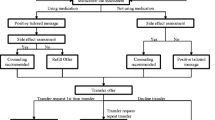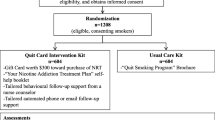Abstract
Background: Experiencing a serious adverse behavior-related consequence may motivate behavior change.Purpose: To examine how a sentinel health event is associated with changes in smoking.Methods: We used a prospective cohort design. Adult emergency department (ED) patients provided demographic data, a smoking history, ratings of quit intentions, and endorsement of self-identified smoking-related health problems. A chart review collected data on acuity, ED disposition, and medical diagnoses. Smoking was reassessed 1 month postvisit. Hierarchical regression analyses were conducted to predict (a) intention to quit, (b) any quit attempt of 24 hr or more, and (3) 7-day abstinence.Results: Of 717 smokers enrolled, 189 (26%) intended to quit within the next month. Of the 253 participants reached 1 month postvisit, 126 (50%) reported they had attempted to quit, with 44 (19%) reporting 7-day abstinence. After controlling for other predictors, several event-related variables, such as having a smoking-related ED visit and being admitted to the hospital, were strong predictors of outcomes.Conclusion: Compared to community-based estimates, many more smokers in our sample attempted to quit and achieved 7-day abstinence. This was especially true among smokers who attributed their ED visit to a smoking-related health problem and who were admitted to the hospital. We discuss the implications for tobacco intervention design in medical settings.
Similar content being viewed by others
References
Centers for Disease Control and Prevention: Smoking cessation during previous year among adults—United States, 1990 and 1991.Morbidity and Mortality Weekly Reports. 1993, July9:504–507.
Trosclair A, Husten CG, Pedersen L, Dhillon I: Cigarette smoking among adults-United States, 2000.Morbidity and Mortality Weekly Reports. 2002,51(29):642–645.
Rigotti NA, McKool KM, Shiffman S: Predictors of smoking cessation after coronary artery bypass graft surgery. Results of a randomized trial with 5-year follow-up.Annals of Internal Medicine. 1994,120(4):287–293.
Taylor CB, Houston-Miller N, Killen JD, DeBusk RF: Smoking cessation after acute myocardial infarction: Effects of a nurse-managed intervention.Annals Internal Medicine. 1990,113(2):118–123.
Zhu S, Melcer T, Sun J, Rosbrook B, Pierce JP: Smoking cessation with and without assistance: A population-based analysis.American Journal of Preventive Medicine. 2000,18(4):305–311.
Ockene JK, Emmons KM, Mermelstein RJ, et al.: Relapse and maintenance issues for smoking cessation.Health Psychology. 2000,19(1 Suppl.):17–31.
Rosal MC, Ockene JK, Ma Y, et al.: Coronary artery smoking intervention study (CASIS): 5-year follow-up.Health Psychology. 1998,17(5):476–478.
Boudreaux ED, Baumann BM, Friedman K, Ziedonis DM: Smoking stage of change and interest in an emergency department-based intervention.Academic Emergency Medicine. 2005,12(3):211–218.
Boudreaux ED, Kim S, Hohrman JL, Clark S, Camargo CA, Jr.: Interest in smoking cessation among emergency department patients.Health Psychology. 2005,24(2):220–224.
Boudreaux ED, Hunter GC, Bos K, Clark S, Camargo CA, Jr.: Predicting smoking stage of change among emergency department patients and visitors.Academic Emergency Medicine. 2006,13(1):39–47.
Lowenstein SR, Koziol-McLain J, Thompson M, et al.: Behavioral risk factors in emergency department patients: A multisite survey.Academic Emergency Medicine. 1998,5(8):781–787.
Bock BC, Becker B, Niaura R, Partridge R: Smoking among emergency chest pain patients: Motivation to quit, risk perception and physician intervention.Nicotine and Tobacco Research. 2000,2(1):93–96.
Bock BC, Becker B, Monteiro R, et al.: Physician intervention and patient risk perception among smokers with acute respiratory illness in the emergency department.Preventive Medicine. 2001,32(2):175–181.
Richman PB, Dinowitz S, Nashed A, Eskin B, Cody R: Prevalence of smokers and nicotine-addicted patients in a suburban emergency department.Academic Emergency Medicine. 1999,6(8):807–810.
Richman PB, Dinowitz S, Nashed AH, et al.: The emergency department as a potential site for smoking cessation intervention: A randomized, controlled trial.Academic Emergency Medicine. 2000,7(4):348–353.
Colby SM, Monti PM, Barnett NP, et al.: Brief motivational interviewing in a hospital setting for adolescent smoking: A preliminary study.Journal of Consulting and Clinical Psychology. 1998,66(3):574–578.
Colby S, Monti P, O’Leary-Tevyaw T, et al.: Brief motivational intervention for adolescent smokers in medical settings.Addictive Behavior. 2005,30:865–874.
Burling TA, Singleton EG, Bigelow GE, Baile WF, Gottlieb SH: Smoking following myocardial infarction: A critical review of the literature.Health Psychology. 1984,3(1):83–96.
Ockene J, Kristeller JL, Goldberg R, et al.: Smoking cessation and severity of disease: The coronary artery smoking intervention study.Health Psychology. 1992,11(2):119–126.
Rohren CL, Croghan IT, Hurt RD, et al.: Predicting smoking cessation outcome in a medical center from stage of readiness: Contemplation versus action. Preventive Medicine. 1994,23(3):335–344.
Clark MA, Hogan JW, Kviz FJ, Prohaska TR: Age and the role of symptomatology in readiness to quit smoking.Addict Behaviors. 1999,24(1):1–16.
Bernstein SL, Becker BM: Preventive care in the emergency department: Diagnosis and management of smoking and smoking-related illness in the emergency department: A systematic review.Academic Emergency Medicine. 2002,9(7):720–729.
Melissa Data Corp:MelissaDATA. Retrieved October 15, 2005 from http://www.melissadata.com/lookups/TaxZip.asp
Heatherton TF, Kozlowski LT, Frecker RC, Fagerstrom KO: The fagerstrom test for nicotine dependence: A revision of the fagerstrom tolerance questionnaire.British Journal of Addiction. 1991,86(9):1119–1127.
Kozlowski LT, Porter CQ, Orleans CT, Pope MA, Heatherton T: Predicting smoking cessation with self-reported measures of nicotine dependence: FTQ, FTND, and HSI.Drug and Alcohol Dependence. 1994,34(3):211–216.
Velicer WF, Diclemente CC, Rossi JS, Prochaska JO: Relapse situations and self-efficacy: An integrative model.Addictive Behavior. 1990,15(3):271–283.
USDHHS: The Surgeon General’s 1989 Report on Reducing the Health Consequences of Smoking: 25 Years of Progress.Morbidity and Mortality Weekly Reports. 1989,2(38 Suppl.):1–32.
Bernstein SL: The impact of smoking-related illness in the ED: An attributable risk model.American Journal of Emergency Medicine. 2002,20(3):161–164.
Mandelberg JH, Kuhn RE, Kohn MA: Epidemiologic analysis of an urban, public emergency department’s frequent users.Academic Emergency Medicine. 2000,7(6):637–646.
Woolard RH, Carty K, Wirtz P, et al.: Research fundamentals: Follow-up of subjects in clinical trials: Addressing subject attrition.Academic Emergency Medicine. 2004,11(8):859–866.
Boudreaux ED, Ary RD, St John B, Mandry CV: Telephone contact of patients visiting a large, municipal emergency department: Can we rely on numbers given during routine registration?Journal of Emergency Medicine. 2000,18(4):409–415.
Ferrigno RF, Bradley K, Werdmann MJ: A simple strategy for improving patient contact after ED discharge.American Journal of Emergency Medicine. 2001,19(1):46–48.
Boudreaux ED, D’Autremont S, Wood K, Jones GN: Predictors of emergency department patient satisfaction: stability over 17 months.Academic Emergency Medicine. 2004,11(1):51–58.
West R, McEwen A, Bolling K, Owen L: Smoking cessation and smoking patterns in the general population: A 1-year follow-up.Addiction. 2001,96(6):891–902.
Bock B, Becker B, Partridge R, Niaura R: Smoking cessation among patients in the chest pain observation unit [Abstract].Annals of Behavioral Medicine. 2005,29S:61.
Leventhal H, Nerenz D, Steele D: Illness representations and coping with health threats. In Baum A, Revernson T, Singer J (eds),Handbook of Psychology and Health, (Vol. IV). Hillsdale, NJ: Lawrence Erlbaum Associates, Inc., 1984, 219–252.
Leventhal H, Benyamini Y, Brownlee S, et al.: Illness representations: Theoretical foundations. In Petrie K, Weinman J (eds),Perceptions of Health and Illness: Current Research and Applications. Amsterdam: Harwood, 1997, 19–45.
Hall S, Weinman J, Marteau TM: The motivating impact of informing women smokers of a link between smoking and cervical cancer: The role of coherence.Health Psychology. 2004,23(4):419–424.
McClure J: Are biomarkers a useful aid in smoking cessation? A review and analysis of the literature.Behavioral Medicine. 2001,27(1):37–47.
McClure J: Motivating prepartum smoking cessation: A consideration of biomarker feedback.Nicotine and Tobacco Research. 2004,6(2 Suppl.):S153-S161.
Moss-Morris R, Weinman J, Petrie KJ, et al.: The Revised Illness Perception Questionnaire (IPQ-R).Psychology and Health. 2002,17(1):1–16.
West R, Sohal T: “Catastrophic” pathways to smoking cessation: Findings from national survey.British Medical Journal. 2006,332:458–460.
Wagner J, Heapy A, Frantsve L, Abbott G, Burg M: Transtheoretical model constructs in smokers with and without medical illness: A second look at the medical effect.Addictive Behavior 2006, 31(7):1283–1289.
Mordan E, Weeks A, Geffrard M, et al.: Expired carbon monoxide validation of self-reported smoking among ED patients.Academic Emergency Medicine. 2005,12(5 Suppl.):45.
Wagenknecht LE, Burke GL, Perkins LL, Haley NJ, Friedman GD: Misclassification of smoking status in the CARDIA study: A comparison of self-report with serum cotinine levels.American Journal of Public Health. 1992,82(1):33–36.
Lassman J: Teachable moments: A paradigm shift.Journal of Emergency Nursing. 2001,27(2):171–175.
Mitka M: “Teachable moments” provide a means for physicians to lower alcohol abuse.Journal of the American Medical Association. 1998,279(22):1767–1768.
Author information
Authors and Affiliations
Corresponding author
Additional information
This study was supported by a NIH/NID K23 Research Career Award (EDB) Grant (DA-16698-01) and a UMDNJ Foundation Seed Grant.
About this article
Cite this article
Boudreaux, E.D., Baumann, B.M., Camargo, C.A. et al. Changes in smoking associated with an acute health event: Theoretical and practical implications. ann. behav. med. 33, 189–199 (2007). https://doi.org/10.1007/BF02879900
Issue Date:
DOI: https://doi.org/10.1007/BF02879900




